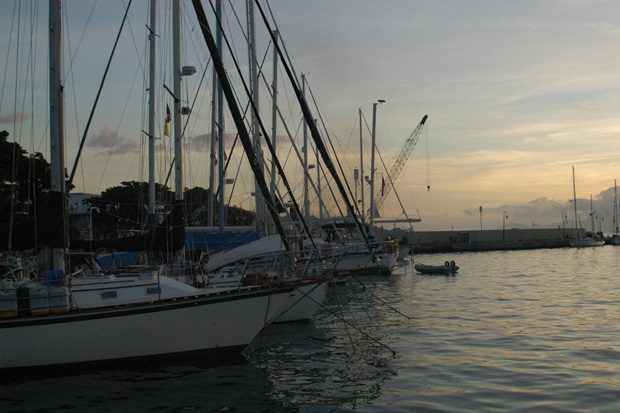Papeete!
Tuesday June 8, 2004
Port du Phaeton, Isthmus of Tahiti Nui and Tahiti Iti
S 17o 43.906’
W 149o 19.588’

We left Rangiroa, Tuamotus through the pass of Tiputa shortly after 2:00 pm on Sunday, May 30th to time our arrival in Tahiti with sufficient daylight for navigation. There are approximately 200 nautical miles of ocean between Rangiroa and Tahiti. Having assumed an average speed of 5 knots, we planned to arrive in Tahiti early Tuesday morning. Cat’s Paw, our nearest neighbor in the anchorage at Rangiroa, had left over an hour earlier, with similar intent.
As the winds would have it, our passage went much faster than anticipated. With a strong breeze from the East, Lillian moved steadily at over 6.5 knots. By 10 pm that night we could see the tricolor lights of Cat’s Paw fall off to port as they maintained their pace for a daylight arrival. We decided to continue under full sail, in case the wind dropped. However, the tradewinds held strong, and by sunset Monday evening, The Lillian B. approached the island of Tahiti a full 12 hours ahead of schedule. Under the benefit of a full moon, we continued our approach towards the main port of Papeete.
All boats approaching Papeete harbor are required to contact harbor control on VHF channel 12 in order to regulate marine traffic and to alert the neighboring Papeete airport of the potential hazard of a tall sailboat mast as it crosses the end of the active runway. In preparation, we monitored the transmission of other boats entering the harbor. The hailing call they used was “Vigie Papeete,” which accordingly to the dictionary translates literally as “Outpost Papeete.” Within two miles of the harbor entrance, I imitated the call, “Vigie Papeete, Vigie Papeete, c’est le voilier Lillian B.” followed by the question “Parlez vous Anglais? ” … do you speak English? (When it comes to matters of navigation, I prefer to place the burden of translation on the controller rather than rely on my high school French.) In this case, the response of the Outpost Papeete to my linguistic query was, “We can” with a tone that implied an unspoken end to the sentence “… if we have to.” With that introduction, I requested to enter the harbor in English, repeated in my best attempt at French, … just to let them know that I could attempt French, … if I had to. They were, in truth, very cordial and granted us permission to enter and spend the night.
Having received our clearance, we turned towards the harbor. The coastline and harbors of Tahiti are well charted and well marked with navigational buoys. At night, the winds around Tahiti and her neighboring islands abate, and the waves were small. The most difficult task was to distinguish the navigational beacons amid the background of lights on shore. The entrance to the harbor itself is flanked by a pair of synchronously flashing red and green buoys that mark an opening in the coral reef. Under the French system, red is on the left and green on the right, when returning to port, the opposite of the US system. At Papeete, the entrance channel is large enough for cruise ships but, at night, it looks deceptively narrow. Waves were breaking gently on the coral to either side. Aiming straight down the middle, Lillian shot through the entrance with plenty of room to spare. Inside, the water was a smooth glossy black surface, reflecting the surrounding harbor lights. It was shortly after 10:00 pm. Following beacons on shore, we glided across the harbor, past the loading docks, in search of an out-of-the-way place to anchor. To starboard was a four lane boulevard, following the shore, backed by multistory building with European architecture. Half a mile ahead, sailboat masts could be seen rising above the waterfront. As we rounded a promenade, we could see a line of sailboats with their sterns tied, “Mediterranean style,” to a quay along the boulevard. In another section, under construction, two boats had docked directly alongside the quay. Given the opportunity to tie up alongside, Peter began to rig for a dock landing, pulling out lines and bumpers while we joked about not remembering how to do a dock landing. With no wind or current, Lillian gently kissed up against the quay, and Peter secured the lines. Lillian was tied directly to shore for the first time since Panama, over 4000 miles ago. Peter and I savored the accomplishment of having brought Lillian from Maine to Tahiti, the lights of a big city, the noise of the highway, and the feeling of stepping directly off onto solid ground.